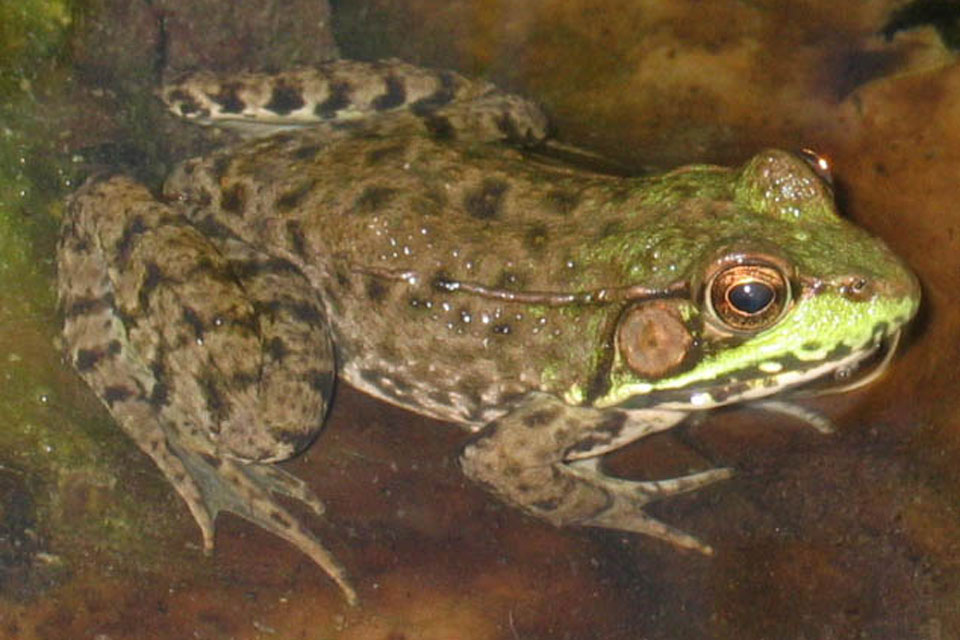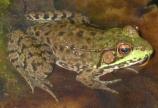Invasive species beware—we have a new way to find you

For years, municipalities on southern Vancouver Island, the Lower Mainland and other parts of southwestern BC have been trying to rid pond ecosystems of a ravenous invader—the American bullfrog. Trouble is, how do you know if you’ve got them all?
Wouldn’t it be great if we could take a scoop of water from a pond and tell if an invasive species has recently been there? Or an endangered species, for that matter. A research group at the University of Victoria can now do just that. Using very sensitive methods, the team can measure the DNA that every organism leaves behind, called environmental DNA—or eDNA for short.
The new technique is described in a paper published this week in the peer-reviewed journal, PLOS ONE. The lead author is UVic molecular biologist Caren Helbing.
For invasive species, early detection is key for successful eradication programs, says Helbing. For species at risk, more accurate distribution maps help guide protection, resource development and remediation efforts.
Traditional methods for identifying the presence of invasive or endangered species involve seeing them directly. These searches can be very destructive to habitat, and many species are difficult to spot even at the best of times.
“The use of eDNA has been around for a few years, but it’s been a ‘wild west’ out there in its application,” says Helbing. “What we’ve done is introduce innovations and standards for the detection of eDNA. It allows us to say with confidence whether an invasive species has entered an area, or determine the range of an endangered or threatened species.”
Helbing and her team have already field-tested the new technique in the Victoria area to detect invasive bullfrogs and the tailed frog, a red-listed native species. Notably, they found evidence that bullfrogs are still in Florence Lake in Langford, despite intense eradication efforts there between 2007 and 2011.
Of 541 species of fish and amphibians in BC, 61 are endangered, threatened or of special concern. Examples include tailed frog, Oregon spotted frog, northern leopard frog, white sturgeon, western toad and red-legged frog. Examples of invasive aquatic species include the bullfrog, zebra mussels, northern pike, yellow perch, rusty crayfish, New Zealand mudsnail and large mouth bass.
“The use of eDNA helps us to better determine the health of our ecosystems by tracking important species,” says Helbing. “Frogs tell us a lot about ecosystem health and by extension, human health, because we have so much in common biologically.”
The study was funded in part by the Natural Sciences and Engineering Research Council and was conducted in collaboration with Hemmera Envirochem Inc. A copy of the paper is available online at http://journals.plos.org/plosone/article/authors?id=10.1371/journal.pone.0164907.
Wouldn’t it be great if we could take a scoop of water from a pond and tell if an invasive species has recently been there? Or an endangered species, for that matter. A research group at the University of Victoria can now do just that. Using very sensitive methods, the team can measure the DNA that every organism leaves behind, called environmental DNA—or eDNA for short.
The new technique is described in a paper published this week in the peer-reviewed journal, PLOS ONE. The lead author is UVic molecular biologist Caren Helbing.
For invasive species, early detection is key for successful eradication programs, says Helbing. For species at risk, more accurate distribution maps help guide protection, resource development and remediation efforts.
Traditional methods for identifying the presence of invasive or endangered species involve seeing them directly. These searches can be very destructive to habitat, and many species are difficult to spot even at the best of times.
“The use of eDNA has been around for a few years, but it’s been a ‘wild west’ out there in its application,” says Helbing. “What we’ve done is introduce innovations and standards for the detection of eDNA. It allows us to say with confidence whether an invasive species has entered an area, or determine the range of an endangered or threatened species.”
Helbing and her team have already field-tested the new technique in the Victoria area to detect invasive bullfrogs and the tailed frog, a red-listed native species. Notably, they found evidence that bullfrogs are still in Florence Lake in Langford, despite intense eradication efforts there between 2007 and 2011.
Of 541 species of fish and amphibians in BC, 61 are endangered, threatened or of special concern. Examples include tailed frog, Oregon spotted frog, northern leopard frog, white sturgeon, western toad and red-legged frog. Examples of invasive aquatic species include the bullfrog, zebra mussels, northern pike, yellow perch, rusty crayfish, New Zealand mudsnail and large mouth bass.
“The use of eDNA helps us to better determine the health of our ecosystems by tracking important species,” says Helbing. “Frogs tell us a lot about ecosystem health and by extension, human health, because we have so much in common biologically.”
The study was funded in part by the Natural Sciences and Engineering Research Council and was conducted in collaboration with Hemmera Envirochem Inc. A copy of the paper is available online at http://journals.plos.org/plosone/article/authors?id=10.1371/journal.pone.0164907.
-- 30 --
Photos
Media contacts
Caren Helbing (Biochemistry and Microbiology) at 250-721-6146 or chelbing@uvic.ca
Val Shore (University Communications + Marketing) at 250-721-7641 or vshore@uvic.ca

